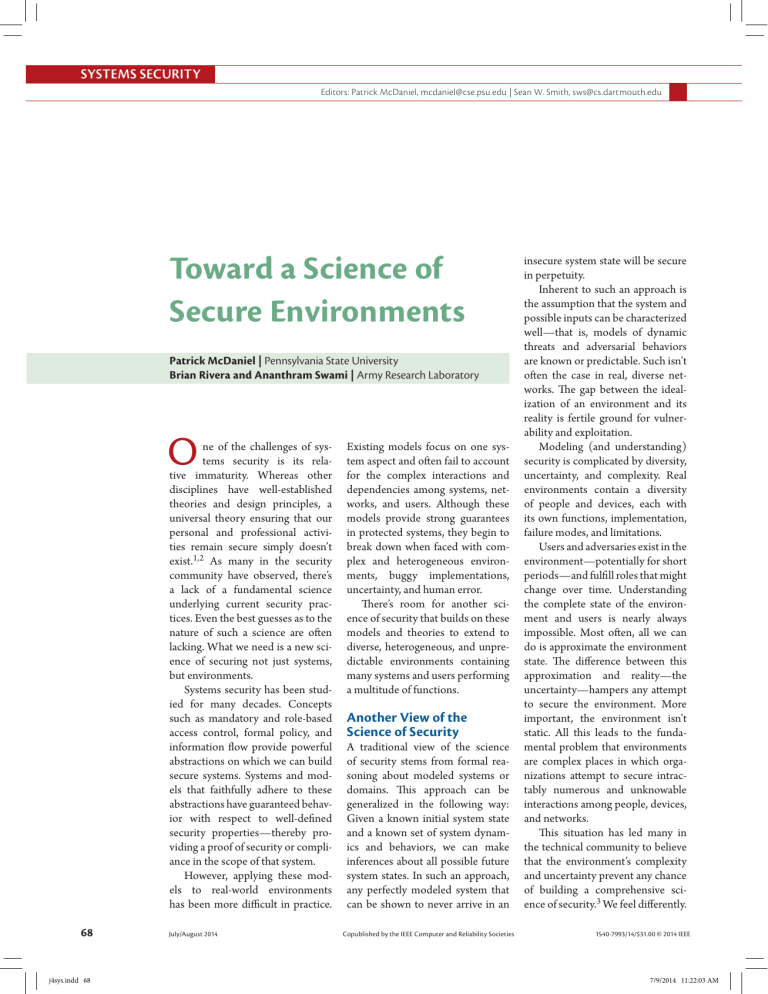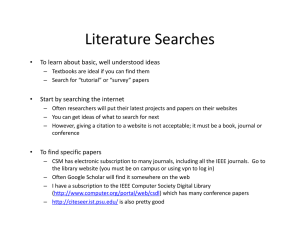
SYSTEMS SECURITY Editors: Patrick McDaniel, mcdaniel@cse.psu.edu | Sean W. Smith, sws@cs.dartmouth.edu Toward a Science of Secure Environments Patrick McDaniel | Pennsylvania State University Brian Rivera and Ananthram Swami | Army Research Laboratory O ne of the challenges of systems security is its relative immaturity. Whereas other disciplines have well-established theories and design principles, a universal theory ensuring that our personal and professional activities remain secure simply doesn’t exist.1,2 As many in the security community have observed, there’s a lack of a fundamental science underlying current security practices. Even the best guesses as to the nature of such a science are often lacking. What we need is a new science of securing not just systems, but environments. Systems security has been studied for many decades. Concepts such as mandatory and role-based access control, formal policy, and information flow provide powerful abstractions on which we can build secure systems. Systems and models that faithfully adhere to these abstractions have guaranteed behavior with respect to well-defined security properties—thereby providing a proof of security or compliance in the scope of that system. However, applying these models to real-world environments has been more difficult in practice. 68 j4sys.indd 68 July/August 2014 Existing models focus on one system aspect and often fail to account for the complex interactions and dependencies among systems, networks, and users. Although these models provide strong guarantees in protected systems, they begin to break down when faced with complex and heterogeneous environments, buggy implementations, uncertainty, and human error. There’s room for another science of security that builds on these models and theories to extend to diverse, heterogeneous, and unpredictable environments containing many systems and users performing a multitude of functions. Another View of the Science of Security A traditional view of the science of security stems from formal reasoning about modeled systems or domains. This approach can be generalized in the following way: Given a known initial system state and a known set of system dynamics and behaviors, we can make inferences about all possible future system states. In such an approach, any perfectly modeled system that can be shown to never arrive in an Copublished by the IEEE Computer and Reliability Societies insecure system state will be secure in perpetuity. Inherent to such an approach is the assumption that the system and possible inputs can be characterized well—that is, models of dynamic threats and adversarial behaviors are known or predictable. Such isn’t often the case in real, diverse networks. The gap between the idealization of an environment and its reality is fertile ground for vulnerability and exploitation. Modeling (and understanding) security is complicated by diversity, uncertainty, and complexity. Real environments contain a diversity of people and devices, each with its own functions, implementation, failure modes, and limitations. Users and adversaries exist in the environment—potentially for short periods—and fulfill roles that might change over time. Understanding the complete state of the environment and users is nearly always impossible. Most often, all we can do is approximate the environment state. The difference between this approximation and reality—the uncertainty—hampers any attempt to secure the environment. More important, the environment isn’t static. All this leads to the fundamental problem that environments are complex places in which organizations attempt to secure intractably numerous and unknowable interactions among people, devices, and networks. This situation has led many in the technical community to believe that the environment’s complexity and uncertainty prevent any chance of building a comprehensive science of security.3 We feel differently. 1540-7993/14/$31.00 © 2014 IEEE 7/9/2014 11:22:03 AM Suppose we reformulate the rea- important step is determining which calculation, even if they aren’t consoning system in the following way: aspects to include in a user model. scious of it. Such decision-making Given a fixed initial approximate Accept that users can subvert even is at the heart of much of practical system and user state, risk assess- the best security apparatus through security, and thus it’s important to ments, and probable behavior sets, negligence, by accident, or through integrate it into a science aimed at what course of action will likely lead malicious action. Such behaviors governing it. to the best outcome? Here, the goal might be more pronounced during Integrating risk into a science is to provide the rigorously derived times of stress, exhaustion, or other of security poses two challenges. optimal reaction to a set of circum- mental or physical states. Thus, we First, recognizing and assessing stances based on our best but inac- can predict the expected behavior risk are fairly hard. Like beauty, risk curate and incomplete knowledge only if we understand a user’s state is in the eye of the beholder. One of the environment and people, in the moment. user’s perceived risk might differ Users’ training and experience significantly from another user’s. including adversaries. This is precisely the science heavily influence their reactions to Context also matters. For example, that the new Cyber-Security Col- security prompts and events. One all other things being equal, the laborative Research Allirisk of browser comproance initiative (http:// mise on a critical system Given a fixed initial approximate system cra.psu.edu)—a 10-year is likely to be very differand user state, risk assessments, and proj­ect spanning five unient from that on a lowversities and the Army value netbook. probable behavior sets, what course of Research Laboratory—­­is The second challenge attempting to form. We action will likely lead to the best outcome? involves weighing risk consider different aspects relative to other needs of this new science, in and risks. Simply recogparticular, models for users, risk view of experience suggests that nizing that particular risks exist isn’t detection, and decision-making in advanced users tend to interpret very in­formative unless you have a partially known environments. security prompts and signals more coherent means to compare them. quickly and correctly, whereas nov- When is it appropriate to browse ices tend to have trouble. Yet, some the network? Is the information Understanding Users Is studies suggest quite the opposite. critical to some other need in the Essential to Security Security models often omit users Furthermore, users often act within network? When do functional entirely or simply view them as groups and communities that influ- needs outweigh risk? What’s the random, untrustworthy actors. ence their behavior. What’s clear is composite risk in a set of sequential In real environments, this limited that experience impacts the cognitive or parallel actions? What are the sigview blinds us to the opportunity processes that lead to decision-mak- nificant sociocognitive factors that to engage and use them to inform ing. Thus, we must integrate notions impact a user’s risk assessment? security decisions. Moreover, fail- of experience into our models. Fortunately, the technical comure to understand users prevents munity has put forth significant us from predicting and reacting to Action Calibrated by Risk effort to develop taxonomies and their behavior. Users are nuanced Risk is the chance that something risk assessments in cybersystems.4 and context-sensitive actors and of value will be lost or impacted, These works have led to initial must be treated as such. Would be it data, trust, availability, time, frameworks for assessing and mana better understanding of users’, or another resource. For example, aging risk and serve as a grounding malicious insiders’, and other there’s a nonzero risk of a user’s mechanism for a science of security. adversaries’ motivations, goals, and browser being compromised when techniques lead to better data secu- surfing websites. Security in com- Understanding the rity? Almost certainly. plex environments is often about Environment State Key to good decision-making is trading risk for availability and Knowing the environment state understanding the users’ state and usability. Users constantly make is also essential to good decisionpredicting how they will react to a set these tradeoffs often without know- making. However, developing perof stimuli. We refer to this as a user ing it, for instance, trading website fect knowledge of the state of a model. However, user models can be access with potential browser com- nontrivial environment is infeasible as diverse as the people who popu- promise. Users make these security owing to its complex and interconlate computing environments. An decisions at least in part via a risk nected nature as well as the systems’ www.computer.org/security j4sys.indd 69 69 7/9/2014 11:22:04 AM SYSTEMS SECURITY inherent randomness, inaccuracies in threat detection, and dynamics of user interactions—both adversary and defender. Thus, developing accurate estimators of the environment state is important. Decision-making systems based on state estimation are well-­practiced in engineering. For example, the principle of physical control systems enables the design of actuator inputs based on approximated physical states and stochastic models of sources of randomness and unmodeled dynamics (“noise”). Indeed, many controls that ensure power grid safety and operation are built on this model. It’s important that the approximation is accurate (within some bounds) and self-correcting over time. State estimation might also lead to new methods of discovering and characterizing anomalous activity, potentially offering new approaches that diverge from contemporary detection systems. An open problem in this effort is determining state estimation’s applicability in the presence of adversarial action. Could adversaries use such estimation as a tool against the protection mechanisms, or can we design these mechanisms to prevent malicious manipulation? The answers to these questions are as yet unknown. One way to reconstruct the environment state is to collect information from many sources and at different system levels. Correlating these sensor inputs into an internally consistent model of the system or environment under inspection is key to developing accurate models. Updating the model with new information while remaining consistent with all available information will help ensure that the state estimate is self-correcting. What information should we collect to make this state estimation? The answer lies in the purposes for and timescales at which it will be used. If we’re making 70 j4sys.indd 70 IEEE Security & Privacy decisions about incident response, we need to understand the nature of each incident and the potential and real impact it has on users and systems around it. users to be more secure in realistic, highly dynamic environments and unknown to the people and organizations securing them. A Science of Optimization References So, given an approximate environment state, how do we determine the action that produces the best outcome? Put another, more practical way: Given an imperfect approximation of the current state, what do we do to best ensure the environment’s security? Suppose that the science can accurately capture the users, risks, and system state. How do we use this information to determine a best course of action? This requires finding a way to determine what best means, and there might be many metrics of interest. If we understand the desired outcomes and the means used to arrive at them, we can weigh different actions’ relative risks and expected outcomes. The desired outcome is the network’s target end state. One course of action here is to maneuver through this state space; each point in the trajectory is associated with risk and utility. Note that the space of maneuvers across which we can optimize is quite large. We can change security policy, allocate new resources, disable or modify services, increase sensor collection, or perform any other alteration that would improve the probability of a positive outcome. U ltimately, the new science of security seeks to minimize risk and optimize utility. It models security as a continuous optimization of the environment given imperfect information and incomplete models of future behaviors. If successful, this complementary departure from traditional cybersecurity science will broaden the scope of investigation to allow 1. Science of Cyber-Security, report no. JSR-10-102, JASON Program Office, MITRE; www.fas.org/irp/ agency/dod/jason/cyber.pdf. 2. F.B. Schneider, “Blueprint for a Science of Cybersecurity,” Next Wave, vol. 19, no. 2, 2012; www.cs.cornell. edu/fbs/publications/SoS.blue print.pdf. 3. T. Longstaff, “Barriers to Achieving a Science of Cybersecurity,” Next Wave, vol. 19, no. 4, 2012; www. nsa.gov/research/tnw/tnw194/ article5.shtml. 4. D. Liu et al., “Security Risk Management Using Incentives,” IEEE Security & Privacy, vol. 9, no. 6, 2011, pp. 20–28. Patrick McDaniel is a computer sci- ence and engineering professor at Pennsylvania State University. Contact him at mcdaniel@cse. psu.edu. Brian Rivera is a branch chief in the Army Research Laboratory’s Network Science Division. Contact him at brian.m.rivera.civ@mail.mil. Ananthram Swami is the senior research scientist in the Army Research Laboratory’s Network Science Division. Contact him at a.swami@ieee.org. Selected CS articles and columns are also available for free at http://ComputingNow.computer.org. Have an idea for a future article? Email editors Patrick McDaniel (mcdaniel@cse.psu.edu) and Sean W. Smith (sws@cs.dartmouth.edu). July/August 2014 7/9/2014 11:22:04 AM

